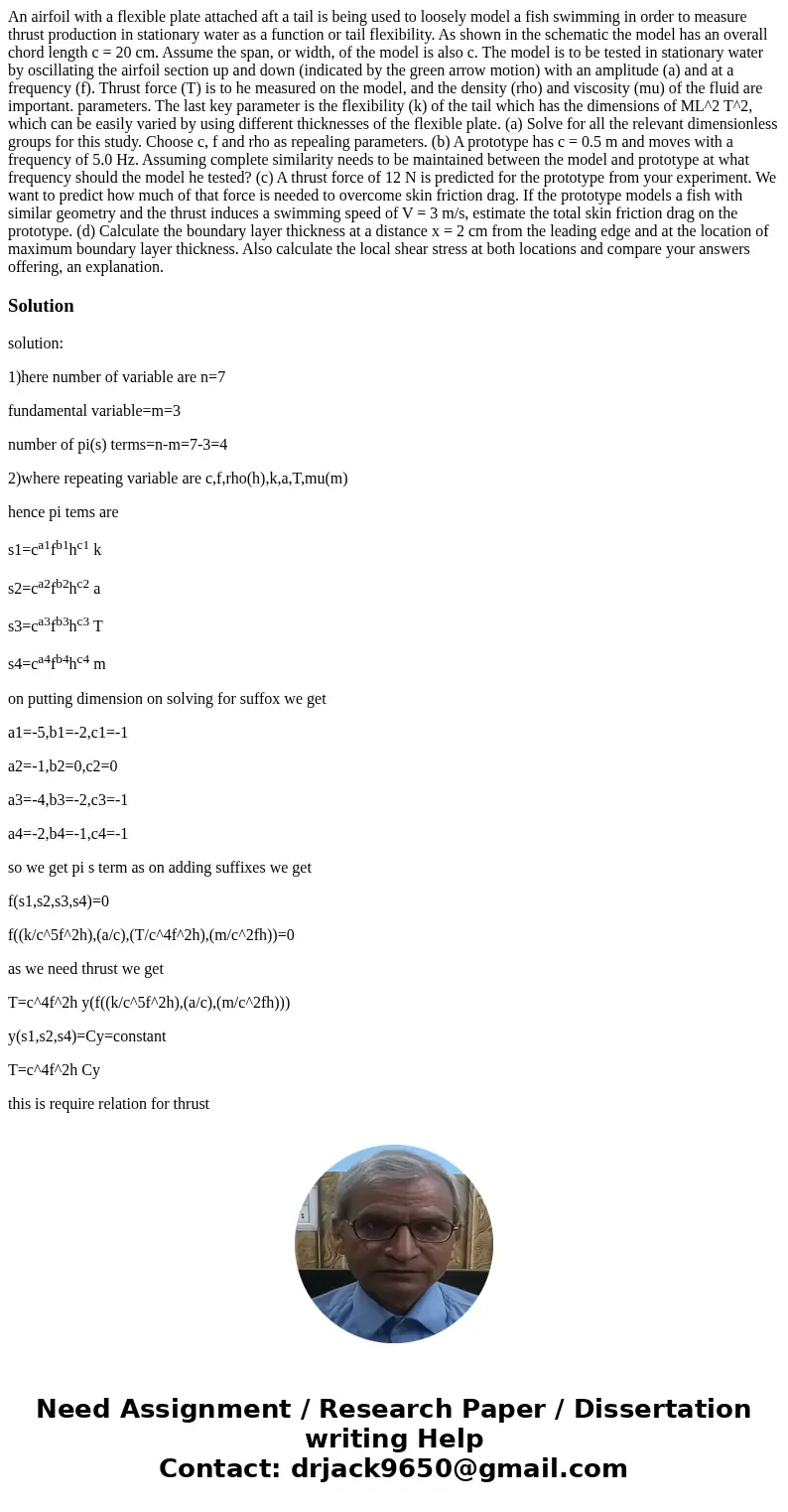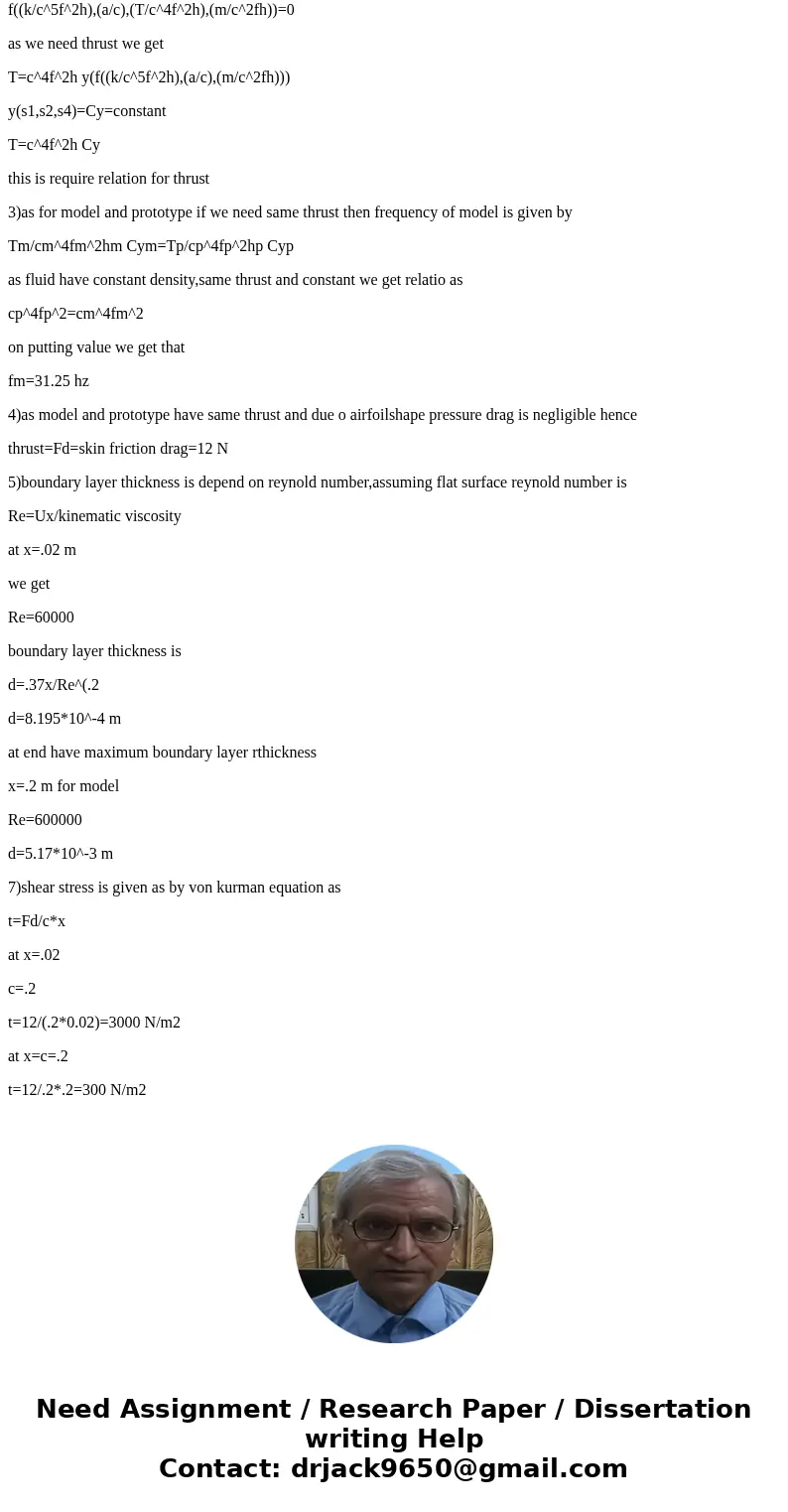An airfoil with a flexible plate attached aft a tail is being used to loosely model a fish swimming in order to measure thrust production in stationary water as a function or tail flexibility. As shown in the schematic the model has an overall chord length c = 20 cm. Assume the span, or width, of the model is also c. The model is to be tested in stationary water by oscillating the airfoil section up and down (indicated by the green arrow motion) with an amplitude (a) and at a frequency (f). Thrust force (T) is to he measured on the model, and the density (rho) and viscosity (mu) of the fluid are important. parameters. The last key parameter is the flexibility (k) of the tail which has the dimensions of ML^2 T^2, which can be easily varied by using different thicknesses of the flexible plate. (a) Solve for all the relevant dimensionless groups for this study. Choose c, f and rho as repealing parameters. (b) A prototype has c = 0.5 m and moves with a frequency of 5.0 Hz. Assuming complete similarity needs to be maintained between the model and prototype at what frequency should the model he tested? (c) A thrust force of 12 N is predicted for the prototype from your experiment. We want to predict how much of that force is needed to overcome skin friction drag. If the prototype models a fish with similar geometry and the thrust induces a swimming speed of V = 3 m/s, estimate the total skin friction drag on the prototype. (d) Calculate the boundary layer thickness at a distance x = 2 cm from the leading edge and at the location of maximum boundary layer thickness. Also calculate the local shear stress at both locations and compare your answers offering, an explanation.
solution:
1)here number of variable are n=7
fundamental variable=m=3
number of pi(s) terms=n-m=7-3=4
2)where repeating variable are c,f,rho(h),k,a,T,mu(m)
hence pi tems are
s1=ca1fb1hc1 k
s2=ca2fb2hc2 a
s3=ca3fb3hc3 T
s4=ca4fb4hc4 m
on putting dimension on solving for suffox we get
a1=-5,b1=-2,c1=-1
a2=-1,b2=0,c2=0
a3=-4,b3=-2,c3=-1
a4=-2,b4=-1,c4=-1
so we get pi s term as on adding suffixes we get
f(s1,s2,s3,s4)=0
f((k/c^5f^2h),(a/c),(T/c^4f^2h),(m/c^2fh))=0
as we need thrust we get
T=c^4f^2h y(f((k/c^5f^2h),(a/c),(m/c^2fh)))
y(s1,s2,s4)=Cy=constant
T=c^4f^2h Cy
this is require relation for thrust
3)as for model and prototype if we need same thrust then frequency of model is given by
Tm/cm^4fm^2hm Cym=Tp/cp^4fp^2hp Cyp
as fluid have constant density,same thrust and constant we get relatio as
cp^4fp^2=cm^4fm^2
on putting value we get that
fm=31.25 hz
4)as model and prototype have same thrust and due o airfoilshape pressure drag is negligible hence
thrust=Fd=skin friction drag=12 N
5)boundary layer thickness is depend on reynold number,assuming flat surface reynold number is
Re=Ux/kinematic viscosity
at x=.02 m
we get
Re=60000
boundary layer thickness is
d=.37x/Re^(.2
d=8.195*10^-4 m
at end have maximum boundary layer rthickness
x=.2 m for model
Re=600000
d=5.17*10^-3 m
7)shear stress is given as by von kurman equation as
t=Fd/c*x
at x=.02
c=.2
t=12/(.2*0.02)=3000 N/m2
at x=c=.2
t=12/.2*.2=300 N/m2


 Homework Sourse
Homework Sourse